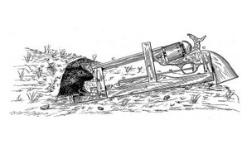When most inventors think of a patent, they think of a better-mousetrap type patent, known as a utility patent. A utility patent protects what an invention is and how it works. U.S. Patent 269,766 for a mousetrap that plugs a mouse with a bullet from a .44 is an example of a utility patent. Our topic today is not utility patents, so rodents are safe for the time being.
Instead, we’ll discuss design patents, which protect the ornamental appearance of an object, not what the object is or what it does. U.S. Patent D717.021 for a hat that looks like a cheese grater is an example of a design patent.

Design patents must meet many of the same requirements of utility patents; namely, the design must be novel and unobvious. To be novel, the design must be new. To be unobvious, the design must be more than a trivial change from what has gone before. O.K, so the design must be new. But how can you tell whether a new design is obvious? The Federal Circuit Court tells us that we must first select a ‘primary reference;’ that is, a single prior art reference with a design that is “basically the same as the claimed design.” The ‘primary reference’ will not include all of the features of the design – otherwise the design would not be novel. So the courts or the USPTO will look to other prior art references to provide any design features not included in the primary reference. The Federal Circuit Court of Appeals considered these issues in the recent case of Campbell Soup v Gamon. Gamon obtained design patents for certain details of a soup can dispenser. Gamon manufactured the soup can dispenser and sold $32 million in dispensers to Campbell Soup. In its SEC filings, Campbell praised the Gamon product and attributed a substantial increase in sales to the use of the Gamon dispensers. After a few years, Campbell Soup apparently tired of paying Gamon and instead started buying direct knock-offs from other suppliers.
Gamon sued Campbell Soup. Campbell Soup initiated inter partes review of Gamon’s patent before the USPTO. Gamon prevailed in the inter partes review (twice) and Campbell Soup appealed to the Federal Circuit (twice).
On August 19, 2021, the Federal Circuit again held against patent owner Gaman and for challenger Campbell Soup. The question before the court was whether the Linz prior art dispenser (on the right) was a proper ‘primary reference’ for the Gamon patent, shown on the left.

But, you exclaim, they don’t look the same! Gamon has all those holes and thingies and Linz has none of that! Isn’t the overall appearance the important test for a design patent?
Clearly you’ve been paying attention. But take a closer look at the drawings. Almost all of the Gamon dispenser is shown in dashed lines. In a design patent, the part of the design shown in dashed lines is not part of the claimed invention and only shows context for the invention. The only parts of that complex dispenser that Gamon actually claimed were (a) the can, (b) the stops that prevented the can from rolling out of the dispenser, and (c) part of the customer display above the can.
The prior art Linz dispenser shows stops for a can and a customer display above the stops, but does not show a can. In the inter partes review, the USPTO concluded that the lack of the can meant that Lenz could not be a primary reference, because the USPTO could not add an element that wasn’t there; namely, the can. The USPTO determined that Linz would otherwise be a proper primary reference, and in fact would render the Gamon dispenser obvious. The Federal Circuit was not troubled by the absence of the can and concluded that the claimed portions of the Gamon and Linz dispensers were ‘virtually indistinguishable.’ The Federal Circuit concluded that the Gamon patent was obvious based on the Linz reference alone.
The court rejected Gamon’s ‘objective evidence’ of non-obviousness in the form of substantial sales, praise of the product and actual copying because Gamon did not show that the substantial sales, praise of the product and actual copying were due to the specific claimed features of the design patent (the can, the stops, and the customer display). In the future it will be difficult to show that factors like commercial success, praise, and actual copying prove non-obviousness of a design patent that, like the Gamon patent, claims only a part of a product.
— Robert Yarbrough, Esq.


